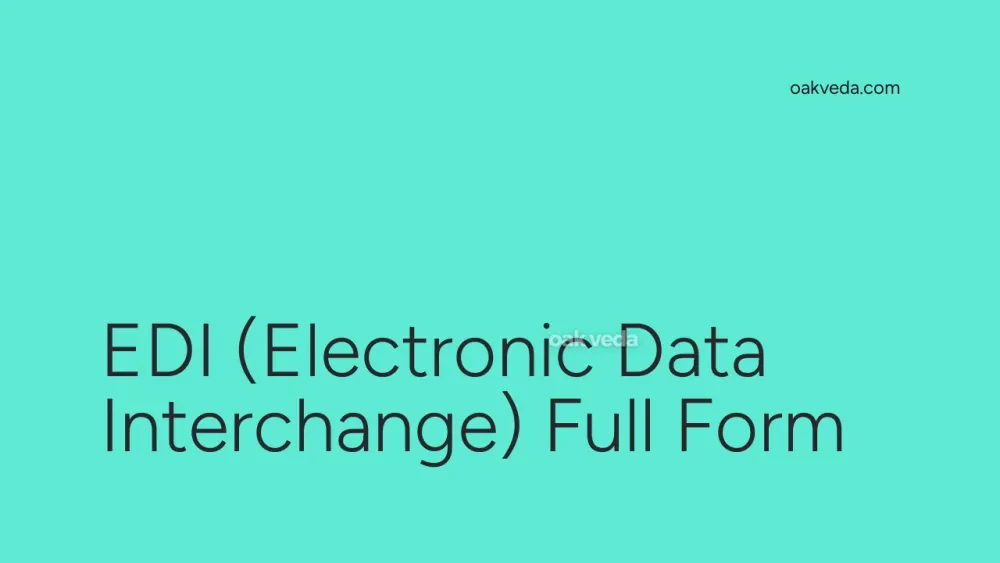
What is the Full Form of EDI?
The full form of EDI is Electronic Data Interchange. This acronym represents a crucial technology in modern business communications, enabling seamless and efficient exchange of information between organizations.
What is Electronic Data Interchange?
Electronic Data Interchange (EDI) is a standardized method for transferring business documents and data between computer systems of different organizations. It allows companies to send and receive information such as purchase orders, invoices, and shipping notices electronically, replacing traditional paper-based methods.
Origin and Development of Electronic Data Interchange
The roots of EDI can be traced back to military logistics advancements in the mid-20th century:
- 1948: The Berlin Airlift necessitated the development of systems to handle large volumes of data about transported goods.
- 1960s: Early EDI concepts emerged from these military logistics practices.
- 1971: The LACES (London Airport Cargo EDP Scheme) system was implemented at Heathrow Airport, marking one of the first integrated EDI systems.
- 1975: The Transportation Data Coordinating Committee (TDCC) in the United States established the first EDI standards.
- 1980s: EDI adoption expanded to various industries, including retail, automotive, and healthcare.
How does Electronic Data Interchange work?
EDI operates by following these key steps:
- Data Preparation: The sender's computer system prepares the data in a standard EDI format.
- Data Transmission: The formatted data is sent securely over a network or the internet.
- Data Reception: The recipient's computer system receives the transmitted data.
- Data Integration: The received data is automatically integrated into the recipient's business systems.
This process eliminates the need for manual data entry and paper-based document exchange, significantly improving efficiency and accuracy.
Types of Electronic Data Interchange
There are several types of EDI systems:
- Direct EDI: Point-to-point connection between two trading partners.
- VAN EDI: Uses a Value-Added Network as an intermediary for data exchange.
- Web EDI: Allows smaller businesses to participate in EDI through web-based interfaces.
- Mobile EDI: Enables EDI transactions through mobile devices.
Functions of Electronic Data Interchange
EDI serves several critical functions in business operations:
- Document Exchange: Facilitates the transfer of various business documents.
- Data Standardization: Ensures consistency in data format across different organizations.
- Process Automation: Automates routine business processes, reducing manual intervention.
- Supply Chain Management: Enhances visibility and coordination throughout the supply chain.
- Financial Transactions: Streamlines invoicing, payments, and other financial processes.
Applications of Electronic Data Interchange
EDI is widely used across various industries and business processes:
- Retail: For purchase orders, invoices, and inventory management.
- Manufacturing: In supply chain management and production planning.
- Healthcare: For claims processing and patient information exchange.
- Transportation: In logistics and freight management.
- Government: For regulatory compliance and reporting.
Features of Electronic Data Interchange
Key features of EDI include:
- Standardization: Uses globally recognized formats like ANSI X12 and EDIFACT.
- Security: Employs encryption and authentication to protect sensitive data.
- Scalability: Can handle high volumes of transactions efficiently.
- Integration: Seamlessly connects with existing business systems.
- Traceability: Provides audit trails for all transactions.
Benefits of Electronic Data Interchange
Implementing EDI offers numerous advantages:
- Cost Reduction: Eliminates paper, printing, and manual processing costs.
- Improved Accuracy: Reduces errors associated with manual data entry.
- Faster Processing: Accelerates business cycles and decision-making.
- Enhanced Relationships: Improves communication and collaboration with business partners.
- Increased Productivity: Frees up staff from routine data entry tasks.
- Environmental Impact: Reduces paper usage, contributing to sustainability efforts.
Limitations or Challenges of Electronic Data Interchange
Despite its benefits, EDI faces some challenges:
- Implementation Costs: Initial setup can be expensive, especially for smaller businesses.
- Complexity: Requires technical expertise to implement and maintain.
- Standardization Issues: Different EDI standards can create compatibility problems.
- Dependency: Reliance on technology can be problematic if systems fail.
- Resistance to Change: Some organizations may be reluctant to adopt new technologies.
Future Developments in Electronic Data Interchange Technology
The future of EDI looks promising with several emerging trends:
- Cloud-based EDI: Offering more flexible and scalable solutions.
- AI and Machine Learning: Enhancing data analysis and predictive capabilities.
- Blockchain Integration: Improving security and traceability of transactions.
- IoT Integration: Connecting EDI with Internet of Things devices for real-time data exchange.
- API-enabled EDI: Allowing for more seamless integration with modern web technologies.
FAQs on EDI Full Form
-
What is the primary purpose of EDI? EDI's main purpose is to facilitate the electronic exchange of business documents between organizations in a standardized format.
-
Is EDI still relevant in today's digital age? Yes, EDI remains highly relevant, especially in industries with complex supply chains and high transaction volumes.
-
How does EDI differ from email communication? Unlike email, EDI uses standardized formats that can be directly processed by computer systems without human intervention.
-
Can small businesses benefit from EDI? Yes, with web-based EDI solutions, small businesses can now participate in EDI without significant infrastructure investments.
-
Is EDI secure? EDI incorporates various security measures, including encryption and authentication, to ensure data protection during transmission.
You may be interested in:

